The story of the Augustin tube lock ignition system

Introduction
The tube lock ignition system is considered a dead-end in the history of firearms. And this is true. This kind of lock system did not evolve into a more modern system as the percussion cap did. But at the time it was developed for the Army of the Hapsburg Empire it seemed a logic and economical decision.
From flintlock to percussion
In the mid 19th century the firearms used by the Hapsburg Army were based on the M 1798 designs with only a few small modifications. These guns proved effective against the armies of Napoleon. In 1807 reverend John Forsythe invented a better, more reliable ignition system, the scent bottle lock, that opened a new route in firearm evolution. It used an exploding compound mixed from mercury-fulminate and potassium-chlorate.
The percussion cap was simultaneously patented by different inventors in the end of the second decade of the century. Joseph Egg, Joshua Shaw, and the French Deboubert all claimed the invention as being the first.
The new ignition method had several advantages. First it cured the greatest problem of the flintlock: the sensitivity to humidity. The flintlock musket’s average failure to fire ratio was around 25% according to the contemporary tests. The priming powder in the pan was extremely sensitive to rain, snow and humidity of the air. The residue of the burning powder inhibited the the flint to make enough sparks on the steel. The flint itself could wear out with loosing the sharp edges.
The new ignition system reduced this ratio dramatically to a level of under 1%. This practically meant that every unit armed with percussion arms had 25% more firepower than a same size unit armed with flintlocks.
The percussion ignition had some more advantages as well. It reduced the lock time so the same length and caliber smooth bore barrels became more accurate in the hands of the soldier. The flash in the pan also disappeared that made aiming easier. The percussion ignition was also stronger than the flintlock, as the flashes of the cap reached deep into the powder chamber, igniting nearly the complete charge immediately, accelerating the bullet in the bore to a higher velocity than the flintlock did with the same powder charge.
The flintlocks had another disadvantage. Upon each firing, the flash hole located on the right side of the musket spit out a large flame straight into the face of the soldier standing to the right. If you ever felt this in the firing line, you know what I am talking about. It is impossible to aim accurately while you receive a cloud of burning powder particles in your face…
Insensitivity to bad weather, reduced lock time, reduced barrel time, no flash in the pan. These features meant a huge leap forward after 200 years of smooth bore flintlock musket times.
Developement of the tube lock
The Habsburg Army reacted slowly to the new challenge. The leadership was aware of the advantages of the new system, but changing the lock on a hunting rifle was a different job than rearming the complete army.
First of all it was a question of economics. The Army and Navy had nearly 800.000 flintlock firearms on hand by those time. This was a huge value that had to be saved somehow. Producing 800.000 new muskets, pistols, carbines, jäger rifles was out of the question because of the insufficient funds. The Habsburg Army needed a solution that saved these old Napoleonic arms.
Second it was a question of soldier straining. It was an extremely slow and hard job to teach the soldiers how to handle the flintlock musket. Rearming them was not just a question of changing the firearms. Retraining them needed many years of practice starting from the officers, NCOs, ending with the individual soldiers. Time and resources to do this were something that the Habsburg Army did not have because of the continuous wars. They needed a firearm with handling methods close to the flintlock, still offering the advantages of the percussion ignition.
Third – and sometimes the most important – factor was the short-sighted decision makers in the Arsenal of Vienna. By those times one of the principal decision maker was Natalis-Felix Beroaldo-Bianchini, head of the Viennese Arsenal. He tested the new percussion cap system and stated it as unfit for service because the caps are too small for the crude hands of the soldiers. Bianchini was right. The small – civilian size – caps he tested were hard to handle. But in the third decade of the century the 6 mm winged caps were also available. But Bianchini did not test them…
The percussion tube is born
And there came a customs officer from Milan. Giuseppe Console was working on modernizing the ignition system of artillery pieces. He patented his system in 1831. The principle was simple: he loaded some black powder mixed with potassium-chlorate into a piece of straw. The hammer hit this straw igniting the compound resulting a hot, fast ignition without the need of flint and steel. The fort of Linz was quickly equipped with the new artillery pieces in 1833. The success was acknowledged by the Kaiser. This opened a new route for the young Italian officer.
Console started to experiment with using the same method on hand held firearms. He searched for an easy and cost effective way to modernize the standard issue flintlocks. His method was really simple, just three parts of the lock had to be changed: a new pan was needed, the frizzen had to be changed to a new, modified piece, and a steel block had to be put into the jaws of the hammer replacing the flint. The new pan was designed to accommodate the priming tube. The new cover was shut on the priming tube. Upon firing the hammer fell on the cover and a sharp edge exploded the tube.
The solution was cheap and easy while the handling method of the gun and cartridge was very close to the flintlock methods. Console was invited to Vienna to convert carbines, jäger rifles and muskets in the Arsenal. The first trials of new system were held from the spring of 1835 in Eger at the 6th jäger regiment. The trials were successful. The converted 1807/35 M Jagerstützen rifles performed well in the hands of the troops. On the 26th August 1835 the Kaiser nominated a committee of three officers to examine the possibility of rearming the complete army with the Console’s invention. A member of this committee was Vincenz von Augustin.
The new trials
The first trials were successful. All the officers and soldiers involved stated the the new firearms were quicker to load (a Console armed soldier fired 12 shots with the new rifle while during the same time period the flint lock armed soldier was only capable of firing 5 shots), the new rifles were more accurate, and the new priming system proved to be less sensitive to water. On 9th January 1836 the Kaiser ordered all Jäger regiments to be equipped with the new system.
However not everybody was happy with the Console locks. Beroaldo-Bianchini did word a list of concerns regarding the tube ignition. Bianchini was generally against the percussion system so this was not such a huge surprise. However he had some really important notes on the subject as well:
1st The percussion tubes were attached to the paper cartridge with a piece of wire. These wires could foul easily in the cartridge box.
2nd If the pan cover was shut too fast it could ignite the tube.
3rd The wires of the tubes were too long, so if the percussion tube accidentally fell between two balls in the cartridge box, the cartridges could go off.
4th The explosion of the tube is too close to the face of the soldier and particles can fly into the aiming eye.
Augustin’s challenge
Bianchini’s notes were important in the further development of the new lock system. However this work was not done by Console, but by Vincenz Augustin, principal inspector of hand held firearms and the artillery in the Viennese Arsenal.
Augustin faced quite a few problems. The biggest challenge was to overcome the size problems of the locks manufactured by different makers. Although the Army had central regulations on the sizes of lock parts since 1798 the system did not work. The Console lock however needed an accurate fitting. If the pan and the flash hole was not in line, the ignition became insecure.
Augustin tried to modify the system to meet the requirements of Bianchini and to overcome the size problems, but was not successful. He had to redesign the complete lock system loosing the opportunity of the conversion of previous flintlock arms. Giving up one of the very first criteria cost the Emipre a lot of time and money.
Augustin’s modifications – the priming tube
Console’s straw priming tube, loaded with mix of black powder and potassium-chlorate was a huge leap forward compared to the flintlock ignition. However its firing certainty was far from the contemporary percussion locks. But this was not the problem of the primer, but the problem of fitting the lock to the barrel. The failure to fire ration of the original Console lock was around 10%. After Augustin modified the lock this ration dropped to 6%. This was better, but also far from the desired “under 1%” level.
Augustin decided to replace the priming compound to a stronger material: mercury-fulminate in 1845. The first factory to manufacture the new primer was the factory of the k.k. Feuerwerks Korps in Wiener Neustadt. Another factory was established in Prague and the Army planned to open a factory in Pest (Hungary) as well. The mercury-fulminate was loaded into a small tube bent from thin brass sheet. The sheet was cut and rolled by machines. One end was closed and drilled to accept the wire. After loading the compound the tube was submerged into lack to completely waterproof the primer.
This manufacturing method was easy and quick. If machines were not available the tube could be rolled by hand as well – a very useful advantage in the later Hungarian freedom fights.
Augustin’s modifications – the cartridges
Console’s original cartridge was an ingenious design. The loading procedure of the standard flintlock cartridge started with biting the end of the paper tube off than priming the pan. To do this, the soldier needed teeth. It was a common way to avoid the long military service to remove the teeth needed for opening the cartridge.
Console solved this problem and closed this little back door. The opening method of his cartridge was simple. The wire of the primer was tied to a felt wad closing the cartridge. The soldier inserted the primer into the “kern”, closed the lid, pulled the cartridge. The wad opened the end of the cartridge so there was no need to bite the end off. This cartridge was a clever design, however it was more complicated than the standard issue cartridges, and it needed three wads instead of one. Bianchini also had some concerns about the length of the wire, so Augustin had to find a simpler way.
He simplified the system. He attached the wire of the primer directly to the paper, and dropped the self opening mechanism. The wire got shorter, so the primer could be hid under the folded end of the paper tube. This cartridge had only one wad behind the ball separating the projectile from the powder charge.
The standard issue musket cartridge held a 24 g, 15,9 mm diameter pressed pure lead round ball and cca. 7.2 g of musket powder. The gap between the barrel and the ball was 1.56 mm – large enough so the ball could easily fall on the powder even in a fouled barrel. The projectile left the bore with 420-430 m/s muzzle velocity.
The 1842 and 1849 M Kammerbüchse rifles had other projectiles. The original 1842 M Kammerbüchse cartridge held a 17,74 mm diameter round ball wrapped in linen patch, tied to the end of the paper cartridge. The Kammerbüchse bore had a nominal diameter of 18,1 mm so the bullet fit tighter, and the lubed patch was able to completely seal the rifled bore. The rifle had a Delvigne-style powder chamber. After loading the powder and ball, the soldier could upset the bullet into the rifling with the heavy ramrod on the walls of this chamber to make the fit even tighter. The original chamber had sheer walls. Later Augustin modified this with rounding the edges to have a better expansion of the bullet. The powder load was 55 gran (1 Viennese gran = 0,07 g), and the muzzle velocity was much lower than the smooth bore muskets velocity. This was necessary as with higher velocity the ball could jump the rifling, not twist with the spiral, therefore could loose accuracy.
In 1847 the first conical bullet of the Habsburg Army entered service for these arms. This was the 41,1 g weighing cylindro-conical bullet. With better ballistic coefficient it was capable of better long range accuracy and penetration. The powder load was the same 55 gran fine schützen powder as with the 1842 M cartridge. The bullet had one deep groove filled with a lubricated felt belt. This belt was responsible for sealing the gases and lubricating the bore. Later in 1853 experiments were made with the Lorenz style compression bullets as well. But the 12 groove rifling of the Kammerbüchse was designed for patched round ball also the caliber was too large for flat trajectory, so the 1853 M bullets did not see service.
Augsutin’s modifications – the lock
We know a lot about the details of the work done by Console and Augustin, but now let’s see what exactly Augustin modified on the lock. The first issue to solve was the misfire problem caused by the inadequate lining of the primer with the touch hole.
As I wrote before, the military lock and lock part standards already existed in the beginning of the 19th century, but they were not used strictly by the gunmakers working for the Arsenal. Therefore Console’s replacement pan and lid did not fit all the guns even if they were from the same type. If the pan and the touch hole were not in line, the flash of the primer could not reach the main charge, therefore ignition was impossible.
Augustin solved this problem with screwing a small metal tube called the “kern” into the touch hole. The “kern” accepted the half of the primer, and directed the flames straight into the flash hole. This “kern” was fitted to the barrel and the lock precisely, so from this time strict military standards were a must.
He also modified the lid or “deckel” (that originally replaced the frizzen) closing on the primer. His lid had a small and light 8 g weighing “zahn” or tooth as a separate part. This tooth had a free movement and it was light and loose enough so it could not set off the primer even if the lid was closed in a crude way. He replaced the flint hammer with steel block in the jaws to a standard percussion hammer.
These locks were manufactured completely on machines and they were absolutely interchangeable. However the new lock required new stocks… The old barrels could be used if they were in good condition, but overall the new system required the manufacturing of a completely new line of guns. The conversion of the flintlocks were out of question from this time.
In the next parts I will introduce the most important tube lock firearms of the Hapsburg Monarchy. Check our film about how it was loaded and shot:
Balázs Németh

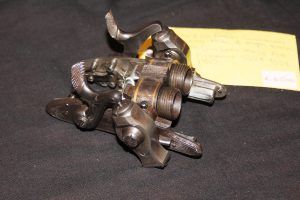
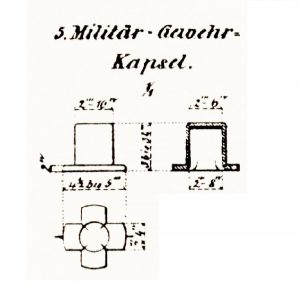
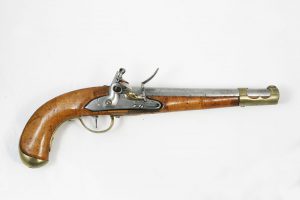


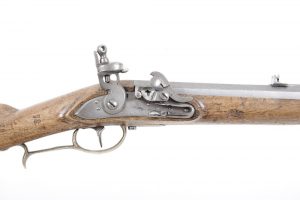
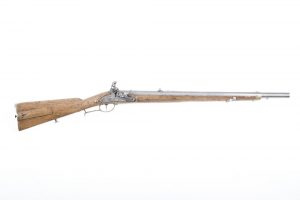



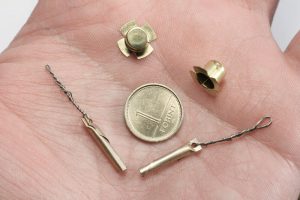





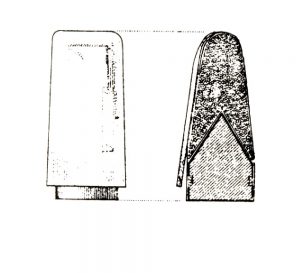























Very interesting evolutionary history from flint to percussion. Many changes in small arms technology were met with distain by “old school” ordinance chiefs for personal and economic reasons. Once “new” devastating technologies took over at the turn of the 20th century, battlefield tactics lagged behind because of “old Generals” causing staggering death tolls and stalemate.
Excellent article! I’m searching some information about tube lock for a long time. I would like to translate it to russian and place it on russian MLA site.